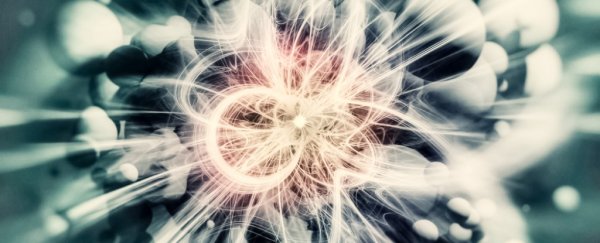An exotic kind of particle so mysterious that it was suspected to be impossible has finally been identified by physicists – and not just once, but twice.
Two new theoretical predictions of an elusive form of matter called tetraquarks provide the firmest evidence yet that these strange particles really do exist after all, setting the stage for an imminent new era of understanding in subatomics.
"We think this is not totally academic," one of the researchers involved, theoretical physicist Chris Quigg from the Fermi National Accelerator Laboratory, told Gizmodo.
"Its discovery may well happen."
If your high school chemistry and physics is a little rusty, below the level of the atom, you've got subatomic particles including protons and neutrons, which are made up of composite particles called hadrons, which are in turn composed of elementary particles called quarks.
The idea of quarks was first proposed back in the 1960s, and ever since then physicists have been investigating how these mystifying particles – which don't have any smaller substructure we're aware of – arrange themselves to help make up the building blocks of matter we can touch and feel.
Now, two separate teams of scientists think they've got firm theoretical evidence of one new such arrangement, called the tetraquark – a stable configuration made up of four quark particles.
It's not the first time researchers have zeroed in on what they think is evidence of tetraquarks – this century, a number of tetraquark candidates have been suggested, although the findings have been mostly theoretical, with observational confirmation eluding scientists.
Last year, the Fermilab team announced the discovery of a particle consistent with a tetraquark – and researchers at the Large Hadron Collider beauty (LHCb) experiment made inroads by finding particles that might be a whole new family of tetraquarks.
But again, confirmation wasn't easy to come by, because the area of research remains exceedingly exotic.
"In the case of tetraquarks, people can always put forward alternative explanations," Quigg told Physics World.
Quarks themselves come in six types, called flavours, which are: up, down, strange, charm, top, and bottom, determined by attributes such as their electric charge, mass, and spin.
Outside of tetraquarks (and the similarly hypothetical pentaquarks), theory conventionally suggests two or three quarks may join up to create a composite particle – in quark-antiquark pairs or three quarks together – but not more.
But in new research, Quigg and fellow Fermi physicist Estia Eichten – along with a separate team from Israel's Tel Aviv University and the University of Chicago – have shown that it's possible after all to have a stable four-quark particle.
Via different theoretical explanations, both teams predict tetraquarks can assemble from two bottom quarks along with an anti-up quark and an anti-down quark – with the anti-quarks being like twins to regular quarks, but with the opposite electrical polarity.
While the methods used differ, one of the researchers, Tel Aviv University's Marek Karliner, points out both team's conclusions are "basically identical on a qualitative level".
Some in the physics community are interpreting that congruence as a positive sign, because it could mean we've finally identified the tetraquark for real this time – an amazing result, since, as Karliner told Live Science, "[t]he suspicion had been for many years that [the tetraquark] is impossible".
It's not over yet though. Now that we've got what looks to be the firmest theoretical evidence that tetraquarks exist, there's still the matter of proving it observationally – either at CERN's Large Hadron Collider, or in another experimental particle accelerator.
There's no telling when this experimental proof might turn up, but for his part, Quigg seems to be feeling quietly confident.
"The things we're talking about are so weird that they couldn't be something else," he told Gizmodo.
"It's just a matter of looking hard for it."
The findings are reported here and here in Physical Review Letters.
